#nonbinary historian
Text
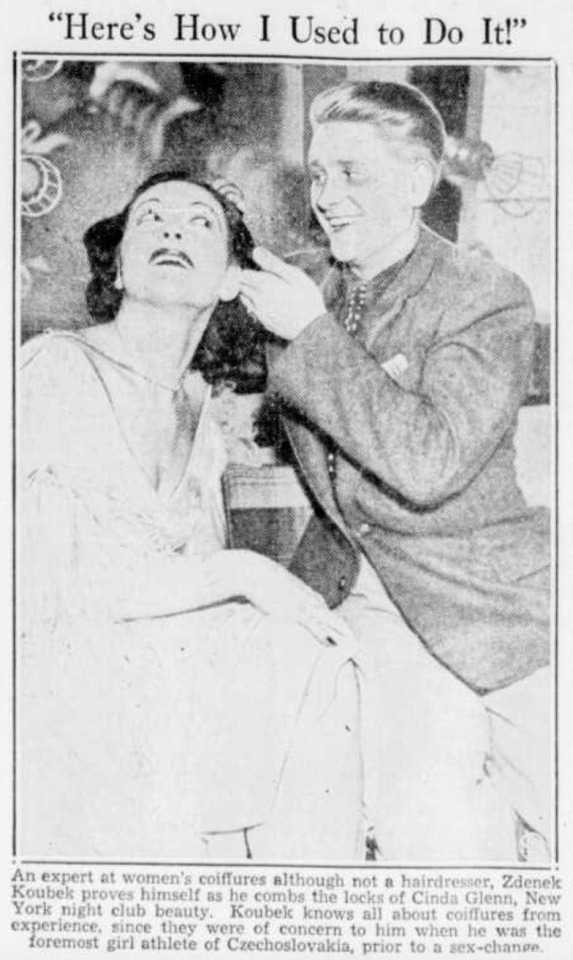
ID: a black and white photo and caption from a newspaper showing a young white trans man with light hair wearing a tweed jacket and high collar smiling at a young white woman in a pale dress as he brushes her mid-length dark hair. She is smiling at him from the slightly complex angle as he brushes her hair. The photo is faded and not great quality but their faces are clear.
The headline over the photo is “Here’s How I Used To Do It!”
The caption below reads “An expert at women's coiffures although not a hairdresser, Zdenek Koubek proves himself as he combs the locks of Cinda Glenn, New York night club beauty. Koubek knows all about coiffures from experience, since they were of concern to him when he was the foremost girl athlete of Czechoslovakia, prior to a sex-change.”
Zdenek Koubek was born in Paskov, Czechoslovakia (at the time) in December 1913, one of eight siblings, and competed as an athlete. With minimal formal training, he began running at age 17, decided to pursue it formally aged 19, and broke two world records at the 1934 world olympics.
Because queer and gender-diverse history is complex, I’m genuinely unsure if Zdenek was intersex. He seems to have been pretty gender-nonconforming when read as a woman in his early life and seems to have retired from athletics because he was harassed by people wanting him to undergo invasive “gender checks” after his gold medals at the 1934 Olympics.
Apparently the current obsession with “defining gender in sport” has roots back to the 1930s. Athletes competing in female athletics have been forced to undergo a variety of examinations for the purpose of declaring them “female enough”. They seem to have never been pleasant, appropriate, or anything other than invasive and dehumanising, and they seem to have always focused on a) defining gender by physicality b) defined that physicality in fairly arbitrary ways that are actually incredibly difficult to relate to anything objective, despite a veneer of scientific objectivity.
I can entirely see why the threat of such harassment would have caused Zdenek to decide an athletic or adjacent career wasn’t worth undergoing it, whether he personally believed himself to be intersex or whether we would recognise him as such today. The term “intersex” has many definitions, and is often challenged by medical professionals if it could potentially cover too many people - e.g. medical professionals have repeatedly challenged the term when used by AFAB people with PCOS, which can cause fertility issues, hirstutism etc, purely on the grounds of “that would make around 10% of women intersex”. Zdenek simply publicly stated “I was wrongly assigned as female at birth” without giving any other details - as he had *every* right to. Some historians have characterised him as intersex based on this, and others simply as trans; he appears, very reasonably, to have preferred to preserve his privacy on the details.
Zdenek went on a lecture tour of the US talking about his life and transitioned in 1936. At the time of this photo, he was pursuing a career in cabaret in the US. He seems to have been reasonably successful but never settled there, returning home and marrying a cis woman with whom he lived happily for the rest of his life, dying in Prague aged 72 in 1986.
He joined a local rugby team along with his brother Jaroslov after WWII and seems to have been an enthusiastic amateur player. I hope he got a lot of joy out of it, which he does seem to have.
Like so many queer and trans histories, Zdenek’s is somewhat obscured because so much of what has been written about him is always skewed by the writer’s own perspectives about gender and transness. Including the drive to impose a false binary on trans experience - which I as a nonbinary person know is certainly not universally present.
There are, of course, *absolutely* trans people who always have a strong feeling of gender equating to “knowing they are a boy/girl from an early age”, and I in no way wish to erase them or their experiences, but it must also be noted and acknowledged there are plenty of us with different experiences. There are people like me who feel “wrong” in our assigned gender from pretty early in life, all the way down to having quite strong dysphoria in puberty and afterwards, but don’t strongly ID as the “opposite” binary gender either. There are people who rub along fine in their assigned gender, or who have many issues with it but don’t know what they equate to, until they have some experience presenting otherwise and suddenly experience strong gender euphoria for the first time in their lives. There are people who never feel anything much at all about gender and only ever do any identifying purely as a matter of convenience because a very binary society requires it.
Cis people seem to find the “always knew/born in the wrong body” narrative the easiest to relate to, and I can only assume that is because it is the narrative that allows them to challenge our society’s gender-essentialist, binarist worldview the *least*. It is considerably easier, and requires much less thought and critical attention, to say “I guess sometimes the occasional person is just mistakenly assigned to the wrong category” than to question those categories, why they exist, what they actually are, how they are imposed, and whether they actually mean anything at all in an objective sense.
I have no idea where Zdenek fell on any of this, or if his experience was very different in another way.
I posted this to, as ever, note that we are not a new phenomenon. Trans people are part of human history. We have always existed. We have always contributed. The way the society we lived in perceived us *and* how the societies our stories have passed through perceived us affect how our stories are told today, and those things can make it complex to uncover the lived experience of the trans person behind all of that. Queer and trans history must always be about acknowledging those facts and uncertainties while doing our best to find out as much as possible about the actual lived experiences of our siblings in the past.
#trans#trans history#queer history#czech history#sports history#historiography#nonbinary#trans historian#nonbinary historian#queer historian#trans man#historical trans man#historical trans person#20th century history#modern history
99 notes
·
View notes
Photo
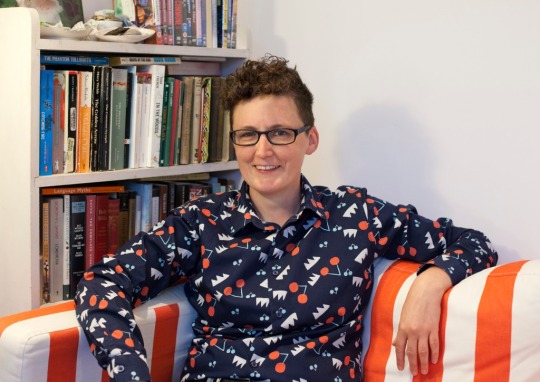
Mo Moulton
Gender: Transgender non binary (they/them)
Sexuality: Queer
DOB: Born 1979
Ethnicity: White - American
Occupation: Historian, writer, professor
#Mo Moulton#lgbt#lgbtq#queerness#nonbinary#non binary#transgender#queer#1979#white#historian#writer#teacher
66 notes
·
View notes
Note
hi! i was reading an article on fashion history today, specifically the 1840s, and it seemed to focus heavily on the idea of clothes relating to female oppression. i was wondering your opinion, if you have the time?
the article is here, https://fashionhistory.fitnyc.edu/1840-1849/
in particular, the article says “Women’s clothes became so constricting that her passivity in society was clear (C.W. Cunnington 135)”. i suppose i’m not entirely sure how valid that is? i’m just looking for another opinion, especially since i’m a complete amateur at fashion history. i know that you’ve talked before about some misconceptions around victorian womenswear, especially with corsets, so i’d love to know if this is of a similar vein to that or if it’s something different with a different background.
if you take the time to respond, thank you so much! i hope you’re doing well :)
This is. A very strange article, providing citiations for opinions as if they were facts. Like...why are you giving a citation for an interpretation of 1840s feminine clothing? I guarantee you won't find anybody in contemporary literature saying "ah yes, women dress like this because they are passive! that is the conscious reason we do this and we have all agreed on it." So it's not really a fact, is it? And therefore, why is it being cited as if it were?
They also seem very determined to believe that these clothes restricted movement to an unmanageable degree. While it's true that you can't bend at the waist easily in 1840s stays, you can still bend at the hips or kneel down. Preventing you from moving in one very specific way doesn't necessarily prevent you from accomplishing the same action with a different movement. It's also bizarre because they talk about women of limited means having access to fashion via ladies' magazines, but don't carry that through to its logical conclusion: working-class women wore similar clothing styles to their upper-class counterparts. And therefore were also wearing stays (practical applications thereof aside). And could ill afford to have their physical action limited. And therefore...? Maybe these garments weren't whalebone cages that kept women from living their lives, perhaps?
Also, this Cunnington fellow they cite for their FactPinions died in 1961. He was active primarily during the period of greatest disdain for all things Victorian- the early to mid 20th century. Are we examining those biases and comparing the opinions expressed therein to modern scholarship, World-Renowned Institution F.I.T.? No! Of course not! Why would we, when Everybody Knows Victorian women's clothing was horrible and restrictive and kept them from doing anything ever? Their society was highly misogynistic, so it must follow that every single thing about their lives was designed to actively oppress them! That's how human beings work, after all! Ahahaha! AHAHAHAHAHAHA!
[Marzi.exe has encountered an error. Please wait.]
Don't get me wrong, he was one of the founders of my main field. He and his wife saved a vast number of garments from being lost forever, and I appreciate that. But he was, as we all are, a product of his time- and that time just happened to absolutely loathe everything about the era he was examining. So I'm not sure why we're taking his word as gospel here- especially when it's not even hard fact.
Like, for example, he says that the scoop bonnets of the era acted like blinders for women, a "moral check" keeping them focused on "the straight and narrow path ahead."
Except. Mr. Cunnington.
Women can turn their heads.
You can just. You can look in another direction. You're not a horse in a head-rein when you put on a coal-scuttle bonnet, so it hardly keeps you from seeing "immoral" things. It is, quite frankly, Not That Deep.
Aaaaand there's the old bugaboo of children's corsets, with a direful comment that girls began "corset training" as young as ten years old. I've gone over this before but, whatever salacious literature of the day may imply, it was not at all common to waist-train young children. Indeed, most so-called "children's corsets" that I've encountered are more like lightly stiffened vests designed for posture support, and can't even be tightened.
There was also at least one very weird technical observation about clothing in here, which surprised me for a fashion school where you'd think at least one person editing their articles would have sewing experience: the comment that the tightly-fitted armsceyes (arm holes) of 1840s bodices kept women from raising their arms above 90 degrees.
I could be wrong, but in my experience a more fitted armsceye allows for MORE freedom of movement, not less. One of the biggest issues I've encountered- and heard other sewists complain about -with modern mass-produced garments is armsceyes cut too large. This may seem counterintuitive, but the principle is something like: Armsceye Cut Close To Armpit = Less Pulling On Body of Garment = Can Raise Arm Higher Without Disturbing Rest Of Shirt/Dress/Whatever. And for an extremely close-fitted garment like a Victorian bodice, that effect could mean that you really CAN'T raise your arm above your head. Trust me; I know this from having made the mistake too many times in my own historical sewing. Now, if the armsceyes were cut very small in general- high in the armpit but very low on the shoulder, too -that maybe could restrict movement somewhat. And I haven't examined many 1840s bodices; it's possible that's how the sloped-shoulder silhouette of the day was achieved.
But I really doubt that all women went around being unable to raise their arms above their heads given that, again, many of them had to work. And it seems weird that a fashion school would simply say "tight armsceyes Bad" without explaining themselves more specifically. Potentially, depending on what they meant, it's even downright ignorant.
In conclusion: the article is correct in a lot of specifics, like the shapes and silhouettes concerned, the trend towards historical inspiration and very subdued ornamentation, etc. It's just when they start trying to interpret the imagined Deeper Meaning of the garments, or extrapolate about the lived experience of wearing them without ever trying it/examining what women actually said about it in the period (or didn't; absence of discussion can be telling in itself) that it starts to go off the rails.
I also feel like it's emblematic of a larger issue within the field, namely: You Can Just Say Whatever The Hell You Want About Dress History And People Will Believe You. One might think academia would be immune to this and more rigorous in its fact-checking, but. One would be wrong. Probably because there have been so many myths floating around for decades, getting repeated over and over, never being questioned because- as I said above -everyone is very very ready to believe that the past was a total hellhole. And most of these myths bolster that image, so...why would anyone doubt them?
Besides the small, unimportant fact that, you know. They're not true.
I don't know. It definitely puts my professional imposter syndrome to flight, I can tell you that much.
#ask#anon#dress history#fashion history#victorian#long post#1840s#also of course there's the fact that dress history has only been a recognized field of study for. Not Long#(hint: It's Misogyny Babes)#(not that it's an entirely feminine topic or field obviously. men wear clothes too)#(and there are male and nonbinary dress historians)#(but. I don't think the fact that it's a topic traditionally associated with women can be overlooked here)#(in terms of its being brushed off and ignored by the wider historical field)
96 notes
·
View notes
Text
Me being gay towards my best friend, a thread.
Fellas is it gay to trespass into a city park at 4:00 in the morning to watch a meter shower and when there are no meters you try to stay until the sun rises?
Hey fellas is it gay to get astrology pencils for someone just because?
Hey fellas is it gay to take multiple screenshots of your best friends when he falls asleep on facetime?
Fellas is it gay for your friend to tell you about a dream he had where you went to the dance together and beet up someone who was mean to you?
and yes all of these things happened to me a year ago and i still didn’t make a move😑
also if you’re reading this… no you’re not… this is not the person you think it is… move along.
#romance#gay couple#gay men#nonbinary loving men#queer stuff#lgbtq#lgbt pride#lgbtpeople#trans pride#transmasc#gay#fellas is it gay#missed opportunity#mentaly ill#friends to lovers#best friend#and historians will call them…
2 notes
·
View notes
Text
At this point I've given up on pleading against the inevitable, if I'm gonna be part of history the least they can do is depict me in the most unenthusiastic, low spirit, "done with this bullshit", tired, character ever if historians ever take interest in my boring life
0 notes
Text
Earlier I talked about people who don't neatly fit within a cis/nonbinary/trans paradigm. It's an expensive, sensitive topic a lot of academics and activists are already talking about. Here's an inconclusive list of people to whom this may apply:
-Lesbians with no particular affinity to womanhood beyond being lesbians
-Same but for gay men
-Same as the first two points but with a big emphasis on butch lesbians and drag queens
-Cis people who have trauma, even dysphoria, with their AGAB, but can't find another gender or label they'd like any better
-Cis people of color who are excluded from eurocentric norms of what it means to look, act, and be cisgender
-Immigrants who had different gender norms in their country or origin who no longer fit in
-Neurodivedvent people for whom gender is just another set of confusing social cues
-Nonbinary people who refer to themselves as their AGAB as shorthand in day to day interaction (similar to choosing a "Starbucks name")
-Nonbinary people who partially identify with their AGAB
-People who view their gender, not as something essential to them, but as imperfect language to refer to a complex range of expressions and experiences
-People who change labels over time but have overlying experiences that transcend these changes
-People who grew up before nonbinary identity really proliferated and still use the nomenclature theyre used to (even if they're not considered cis by contemporary standards)
-People questioning their identity
-People who don't relate to western philosophical notions of "the self."
-People for whom their gender is, well, kind of hard to explain.
Cis is still an important term when denoting power dynamics, especially on a broad sociological level. But on a personal level, this category very often falls apart. Language can only do so much. Anyway, there's a lot I still don't know but I just listened to an excellent episode of the Gender Reveal podcast with trans historian Jules Gill-Peterson where they discuss they question what it means to be cis (and how it applies to institutions vs individuals), along with so many other topics that I found fascinating. Give them a listen!
17K notes
·
View notes
Text
Brain is Stressy Spaghetti
Ok...so more stuff is happening and I'm freaking out a little. I am now a part of an all woman trio of professional singers called the Stage Foundation Singers. I am also going to start filming "Constance", which is the film I'm the lead in, mid May.
Then, we are going to break for the hot season and I'm going to do rehearsals for Man of La Mancha where I get to play a pretty much straight acting role and a bitch to boot. I love playing those type of characters.
I'm also finishing a book that I took a break on due to the person I was working on it with being a total jerk and I wanted to separate myself from that work cause it was causing me a lot of emotional pain but the person is going to pay me for my work so I have to finish it. I also have to figure out a cover design...OOF.
Another thing that I am dealing with is that I am non binary. I am trying out a new name. It is Maven. I am She/ Fae and I am still getting used to it cause I am so used to going by my birth name. All the people I have told so far have been accepting as all heck but my mom almost got mad when I hinted at possibly being non binary. She said, "You're a woman and you identify as a woman. Only because I haven't had any other option.
0 notes
Text


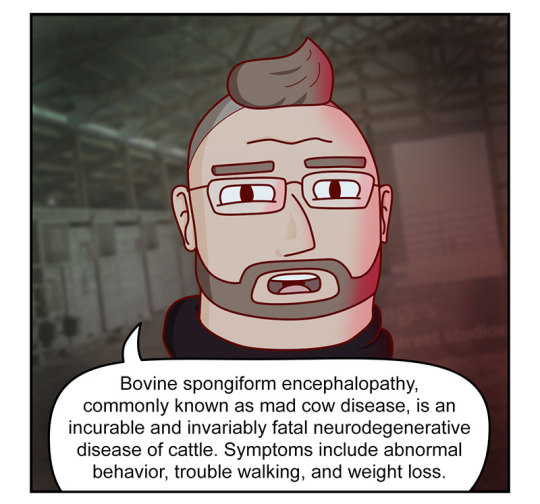
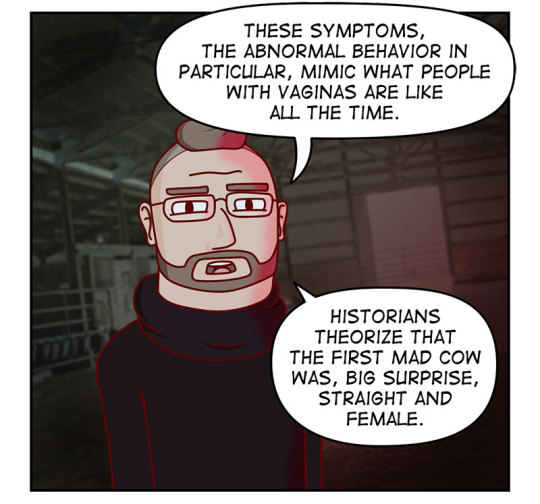
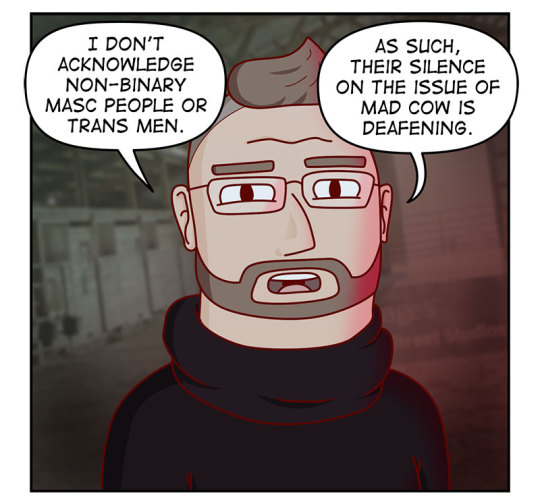

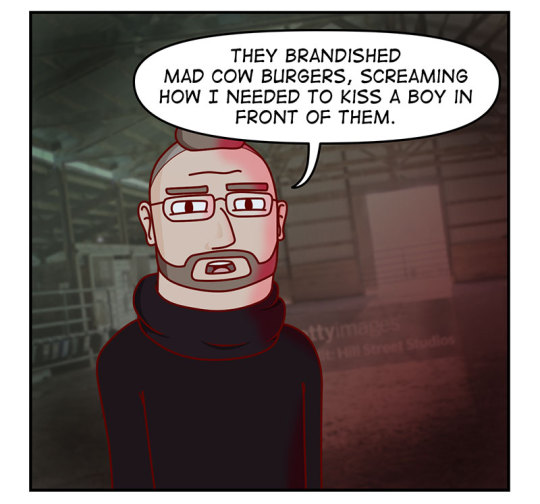



You may have seen a video on the internet recently. As have I!
A comic strip, Vampigeon by Josh Jennings.
Panel 1:
Caption: It’s not all bad, James Somerton fans. Now that you know his formula, you can make an infinite number of his videos using only the power of your imagination
Panel 2:
[A title card, with Stock Footage of cows with color filters and the text "Moo, Britannia by James Somerton."]
Panel 3:
[YouTube Other People's Words Reader James Somerton presents a video.]
James (Encyclopedia Text): Bovine spongiform encephalopathy (BSE), commonly known as mad cow disease, is an incurable and invariably fatal neurodegenerative disease of cattle. Symptoms include abnormal behavior, trouble walking, and weight loss.
Panel 4:
James (Standard Dialogue): Historians theorize that the first Mad Cow was, big surprise, straight and female. These symptoms, the abnormal behavior in particular, mimic what people with vaginas are like all the time.
Panel 5:
James (Standard Dialogue): I don't acknowledge nonbinary masc people or trans men, and, as such, their silence on the issue of Mad Cow…is deafening.
Panel 6:
James (Standard Dialogue): Once, I was walking down the street at night, when a pack of roving vaginas attacked me.
Panel 7:
James (Standard Dialogue): They brandished Mad Cow Burgers, screaming about I needed to kiss a boy in front of them.
Panel 8:
James (Standard Dialogue): I managed to get into my home, but I could still hear the scraping of their claws against the glass. Hear their sickening howls, bragging about how women don't have problems.
Panel 9:
[beat]
Panel 10:
James (Encyclopedia Text): Currently the only reliable test for Mad Cow is examination of tissues during a necropsy citation needed.
768 notes
·
View notes
Note
personally I would love a poll for hot vintage actors/celebrities who played with gender and androgyny or were outright trans/nonbinary, but I'm not sure how many there are or how much time you have to dedicate to the polls so I'll throw it out there for any followers who want to start their own poll
I thought about doing this, but it would be an impossible poll to run fairly for a couple of reasons. (I'm going to be using the word "queer" here as a catch-all term for trans/nb/gender-nonconforming presentation, in the hope that we all understand I'm using it in the reclaimed sense.)
For one thing, being queer was so heavily silenced, punished, and/or criminalized we can't say with any certainty which hotties were trans/nb/questioning. It's possible many of these hot vintage performers would have come out if it had been safe to do so, but we can't tell from this distance. I would hate to exclude anyone just because they don't read as queer "enough" to my eyes, when for them they were just busy surviving.
The other thing is that even as recently as the vintage era of these polls, queerness sat a little differently than it does today. Just as modern historians can't project current systems of gender on figures from the past, I would feel uncomfortable assuming that someone might be trans/nonbinary/gender nonconforming just because they would be read that way today. There's been a lot of cultural shift over the last 100 years where certain things that used to be considered very radical and genderqueer are now utterly normal (ie, women wearing pants) and other things that now read as queer would not have raised an eyebrow then (ie, the oft-quoted article from 1918 that posits that pink is a boys' color, or the entirety of the classic Wings).
In a way, this is freeing—watching vintage movies shows many different ways of framing gender and sexuality, and while some of it is the kind of dated binary we expect, some of it is like light pouring through a window. There are many different ways of framing a gender! The whole concept of gender is moveable and transient! Queerness is as much a part of human nature as love, and teeth, and bones, and touch! But because it was a different era, and because the secrecy prevalent at the time doesn't fully let us know who was or wasn't part of the community, we can't really say for sure (without a lot of extra research, and lots of very careful framing) who was doing things with gender we would today translate as trans, nonbinary, or queer.
Hope this makes sense!
#asks#i hope this comes through w/ the respect for vintage trans nb people i intend. i just don't think it's our right to pry or rank#(as a bracket inevitably does) in a case as tender as this.#happy to talk more if some of my ideas or references don't make sense!#queer vintage#lgbtq+
267 notes
·
View notes
Text
By: Colin Wright
Published: May 3, 2023
The transgender movement has left many intelligent Americans confused about sex. Asked to define the word “woman” during her Supreme Court confirmation hearings last year, Ketanji Brown Jackson demurred, saying “I’m not a biologist.” I am a biologist, and I’m here to help.
Are sex categories in humans empirically real, immutable and binary, or are they mere “social constructs”? The question has public-policy implications related to sex-based legal protections and medicine, including whether males should be allowed in female sports, prisons and other spaces that have historically been segregated by sex for reasons of fairness and safety.
Chase Strangio of the American Civil Liberties Union frequently claims that the binary concept of sex is a recent invention “exclusively for the purposes of excluding trans people from legal protections.” Scottish politician Maggie Chapman asserted in December that her rejection of the “binary and immutable” nature of sex was her motivation for pursuing “comprehensive gender recognition for nonbinary people in Scotland.” (“Nonbinary” people are those who “identify” as neither male nor female.)
When biologists claim that sex is binary, we mean something straightforward: There are only two sexes. This is true throughout the plant and animal kingdoms. An organism’s sex is defined by the type of gamete (sperm or ova) it has the function of producing. Males have the function of producing sperm, or small gametes; females, ova, or large ones. Because there is no third gamete type, there are only two sexes. Sex is binary.
Intersex people, whose genitalia appear ambiguous or mixed, don’t undermine the sex binary. Many gender ideologues, however, falsely claim the existence of intersex conditions renders the categories “male” and “female” arbitrary and meaningless. In “Hermaphrodites and the Medical Invention of Sex” (1998), the historian of science Alice Dreger writes: “Hermaphroditism causes a great deal of confusion, more than one might at first appreciate, because—as we will see again and again—the discovery of a ‘hermaphroditic’ body raises doubts not just about the particular body in question, but about all bodies. The questioned body forces us to ask what exactly it is—if anything—that makes the rest of us unquestionable.”
In reality, the existence of borderline cases no more raises questions about everyone else’s sex than the existence of dawn and dusk casts doubt on day and night. For the vast majority of people, their sex is obvious. And our society isn’t experiencing a sudden dramatic surge in people born with ambiguous genitalia. We are experiencing a surge in people who are unambiguously one sex claiming to “identify” as the opposite sex or as something other than male or female.
Gender ideology seeks to portray sex as so incomprehensibly complex and multivariable that our traditional practice of classifying people as simply either male or female is grossly outdated and should be abandoned for a revolutionary concept of “gender identity.” This entails that males wouldn’t be barred from female sports, women’s prisons or any other space previously segregated according to our supposedly antiquated notions of “biological sex,” so long as they “identify” as female.
But “intersex” and “transgender” mean entirely different things. Intersex people have rare developmental conditions that result in apparent sex ambiguity. Most transgender people aren’t sexually ambiguous at all but merely “identify” as something other than their biological sex.
Once you’re conscious of this distinction, you will begin to notice gender ideologues attempting to steer discussions away from whether men who identify as women should be allowed to compete in female sports toward prominent intersex athletes like South African runner Caster Semenya. Why? Because so long as they’ve got you on your heels making difficult judgment calls on a slew of complex intersex conditions, they’ve succeeded in drawing your attention away from easy calls on unquestionably male athletes like 2022 NCAA Division I women’s swimming and diving champion Lia Thomas. They shift the focus to intersex to distract from transgender.
Acknowledging the existence of rare difficult cases doesn’t weaken the position or arguments against allowing males in female sports, prisons, restrooms and other female-only spaces. In fact, it’s a much stronger approach because it makes a crucial distinction that the ideologues are at pains to obscure.
Crafting policy to exclude males who identify as women, or “trans women,” from female sports, prisons and other female-only spaces isn’t complicated. Trans women are unambiguously male, so the chances that a doctor incorrectly recorded their sex at birth is zero. Any “transgender policy” designed to protect female spaces need only specify that participants must have been recorded (or “assigned,” in the current jargon) female at birth.
Crafting effective intersex policies is more complicated, but the problem of intersex athletes in female sports is less pressing than that of males in female sports, and there seem to be no current concerns arising from intersex people using female spaces. It should be up to individual organizations to decide which criteria or cut-offs should be used to keep female spaces safe and, in the context of sports, safe and fair. It is imperative, however, that such policies be rooted in properties of bodies, not “identity.” Identity alone is irrelevant to issues of fairness and safety.
Ideologues are wrong to insist that the biology of sex is so complex as to defy all categorization. They’re also wrong to represent the sex binary in an overly simplistic way. The biology of sex isn’t quite as simple as common sense, but common sense will get you a long way in understanding it.
#Colin Wright#biology#queer theory#gender ideology#biological sex#sex is binary#intersex#sex denialism#biology denial#sex binary#gender identity#personal identity#identity#identity politics
708 notes
·
View notes
Text

Zimadar (they/them)
one popular occupation among the royal families of Janalila (and the rest of the Hidlawonen (the name of the world in my wip) is by being a "kalimbahin", aka a "prized princess"- Kalimbahin are taught from childhood to be expert historians and songstresses- They are inspired from the "Binukot" ("hidden women") of the southern / central philippines-
The scribes are scholarly, but the kalimbahin are courtly historians, often recounting history and religion by chanting and singing.. Many kalimbahin are said to be the most beautiful women (though many are also nonbinary) in the remaining world. No one is allowed to see them, they often hide behind fabulous, curtained palanquins, and when they perform at court, only the delightful silhouettes of their bodies are shown off via a fire lit behind them (like how shadowplays are done) The kalimbahin's auspiciousness becomes lesser when she begins her period, and she retires with honor from being a kalimbahin once she marries- which is why many royal families of Janalila beg the gods for a trans daughter so she may be an auspicious kalimbahin FOREVER.
This Kalimbahin's name is Zimadar, and they are the twin "brother" of another Kalimbahin named Maputli- However, Maputli was retired from princesshood in a very disgraceful manner, and Zimadar, who is a prince, secretly took her place to spare her and their family shame
361 notes
·
View notes
Text

It’s like “gender” is *actually* a social construct or some shit.
And not only is what any gender means very specific to a specific culture, regardless of the phenotype current people link it to, but even then not everyone in that given culture expresses it the same way, and some people *always* push what that gender and gender expression means.
Because “gender” is not only a social construct; it is a *continuously evolving* social construct.
Queer historians are good at noting that “although we might call x a trans man/a gay man/a nonbinary person etc etc if they lived today, these ideas did not make sense in the social context they lived in”. Historians in general need to get better at realising and elucidating that our modern Western concepts of “man” and “woman” are very different from, and in many ways may not even be recognisable, in, say, medieval Europe, Ancient Rome, medieval/early modern Incan societies, early modern Madagascar, prehistoric Pacific Islander societies, Heian period Japan etc etc, just because we are broadly applying them to many people with similar biological phenotypes.
#prehistoric history#history#gender#gender in history#queer history#the fucking victorians and their long fucking shadow in history#women’s history#gender is a continuously evolving social construct
292 notes
·
View notes
Note
Hi, first time ever sending an ask like this but I needed to tell you how much I love what you write and that I am absolutely grateful you also write for amab sevika 🥺🙏❤️ I was wondering if you maybe would write amab sevika having sex with an insecure afab nonbinary reader and Sev kissing their top surgery scars and doing a bit of body worship? 🥺 Thank you 😭🙏❤️
of course!! this is gonna be a little less smutty because i just wrote a big ol' smut piece last night so i'm all smutted out rn, so i hope that's okay!
disclaimer! i'm cis, so i'm unfamiliar with the specifics of top surgery. if i got anything wrong, please lmk and i'll fix it right away! :)
men and minors dni
first of all, if you guys are together when you get top surgery, sevika would almost be more excited than you.
it's not that she doesn't love your tits. (she does.)
but she loves you so much more, and she knows top surgery is going to make you so happy, and she's so excited for you.
your recovery is uncomfortable and painful as it always is, but it's a little more bearable when sevika's waiting on you hand and foot, grinning each time she changes your bandages and sees your still-swollen but now flat chest.
each night, she'd insist she be the one to rub your scar-fading cream over the scars on your chest.
and each time, she'd press a kiss right over your heart as she rubs it in.
when you're fully healed, sevika wouldn't be able to keep her hands to herself.
not really in a sexual context (we'll get to that in a second) but just because she wants to reassure you and touch you and soothe the scars on your chest.
she's always tracing over the scars, slipping her hand up your shirt to gently rub her thumb back and forth over them.
if you're ever feeling insecure (maybe the scars are lopsided or really obvious, maybe your nipples look a little different now, or you don't have any at all, maybe you're just feeling blah about your body) sevika's the first person to notice something's off-- sometimes even before you do.
"what's wrong?" sevika asks when she wanders into the bathroom and finds you tracing your top surgery scars. you huff.
"nothin'." you say. she shoots you a skeptical look as she approaches you, both hands on your hips and her chin hooking over your shoulder to lock eyes with you in the mirror.
slowly, her hands creep up your side until she's holding your chest, gently tracing over the scars as she presses kisses to your neck and cheek.
"i love you." she whispers. "you're perfect, y'know." she says.
(it's always easy to believe her, especially when you can feel her dick growing hard against your ass.)
in the bedroom, sevika'd always have her mouth on your scars. tracing them with her tongue, pressing kisses to the center of your chest or your nipples, sucking hickeys underneath the scars to decorate them.
she still sleeps on your chest-- slightly less comfortable now without the fat of your breasts to cushion her-- but she doesn't care.
sometimes, you wake up to her whispering secrets to the scars.
"so pretty. so perfect."
"fuckin' sexy ass body."
and your favorite so far, "you made 'em so happy. never saw 'em smile as big as they did when they first saw their new chest. thank you." whispered reverently against the scar tissue on your skin.
you had to snap your eyes shut to pretend to be sleeping when she pulled back away, not wanting her to know you caught her.
she knows, though. she can hear your rapid heart beat beneath her ear as she settles back down. she doesn't say anything, just presses a kiss to your skin, a smile on her lips.
taglist!
@lesbeaniegreenie @fyeahnix @sapphicsgirl @half-of-a-gay @ellabslut @thesevi0lentdelights @sexysapphicshopowner @shimtarofstupidity @love-sugarr @chuucanchuucan @222danielaa @badbye666 @femme-historian @lia-winther @gr0ssz0mbi3 @ellsss @sevikaspillowprincess
#sevika#sevika imagine#sevika arcane#sevika x reader#sevika x you#soft sevika#i hope u like it anon!!!
35 notes
·
View notes
Text
Celebrating Black Queer Icons:
Tourmaline
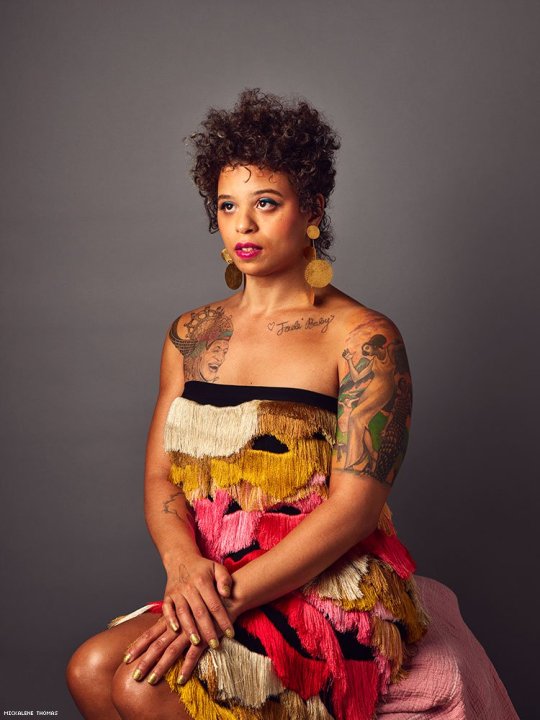

Tourmaline (formerly known/credited as Reian Gossett)is a trans woman that actively identifies as queer, and is best known for her work in trans activism and economic justice. Tourmaline was born July 20, 1983, in the Commonwealth of Massachusetts. Tourmaline's mother was a feminist and union organizer, her father a self defense instructor and anti-imprisonment advocate. Growing up in this atmosphere allowed Tourmaline to explore her identity and encouraged her to fight in what she believes in.
Tourmaline has earned a BA in Comparative Ethnic Studies, from Colombia University. During her time at Colombia U, Tourmaline taught creative writing courses to inmates at Riker's Island Correctional Institute, through a school program known as Island Academy. Tourmaline has worked with many groups and organizations in her pursuit of justice. She served as the Membership Coordinator for Queers For Economic Justice, Director of Membership at the Sylvia Rivera Law Project, and as a Featured Speaker for GLAAD. Tourmaline also works as a historian and archivist for drag queens and trans people associated with the 1969 Stonewall Inn Uprising. She started doing this after noticing how little trans material was being archived, saying that what little did get archived was done so accidentally.
In 2010 Tourmaline began her work in film by gathering oral histories from queer New Yorkers for Kagendo Murungi's Taking Freedom Home. In 2016 Tourmaline directed her first film The Personal Things, which featured trans elder Miss Major Griffin-Gracy. For the film Tourmaline was awarded the 2017 Queer Art Prize. Tourmaline served as the Assistant Director to Dee Rees on the Golden Globe nominated historical drama, Mudbound. Tourmaline has co produced two projects with fellow filmmaker and activist Sasha Wortzel. The first was STAR People Are Beautiful, about the work of Sylvia Rivera and Street Transvestite Action Revolutionaries. The second was Happy Birthday, Marsha, about Marsha P Johnson. Happy Birthday, Marsha had all trans roles played by trans actors. Tourmaline's work is featured or archived in several major museums and galleries. In 2017 her work was featured in New Museum's exhibit Trigger: Gender as a Tool and a Weapon. In 2020 the Museum of Modern Art acquired Tourmaline's 2019 film Salacia, a project about Mary Jones. In 2021 the Metropolitan Museum of Art acquired two of Tourmaline's works for display in Before Yesterday We Could Fly: An Afrofuturist Period Room.
Tourmaline is also the sibling of:
Che Gossett

Che Gossett is a nonbinary, trans femme writer and archivist. Gossett specializes in queer/trans studies, aesthetic theory, abolitionist thought and black study. Gossett received a Doctorate in Women's and Gender Studies, from Rutgers University, in 2021. They have also received a BA in African American Studies from Morehouse college, a MAT in Social Studios from Brown University, and a MA in History from the University of Pennsylvania. Gossett has held a fellowship at Yale, and currently holds fellowships at Harvard, Oxford, and Cambridge. Gossett's writing has been published in a number of anthologies and they have lectured and performed at several museums and galleries of note, including the Museum of Modern Art and A.I.R. Gallery. Gossett is currently working on finishing a political biography of queer Japanese-American AIDS activist Kiyoshi Kuromiya.
I originally intended to do separate profiles for Che Gossett Tourmaline, but could not find sufficient information about Che Gossett, beyond their credentials and current academic activity. That means that this will be the last of these write ups for a bit. I plan on picking it back up in October for the US's LGBT History Month and UK's Black History month. With time to plan ahead and research more I hope to diversify my list geographically and improve formatting. I plan on starting to include cis icons as well, like Rustin Bayard. If you come across this or any other of these posts Ive made this month I would love feedback and suggestions for figures you would like to see covered.
#celebrating black queer icons#black history#black history month#black history is queer history#black history is american history#queer history#tourmaline#che gossett#trans film#trans history#stonewall inn#stonewall uprising#stonewall riots#queer#lgbtq#trans#transgender#nonbinary
206 notes
·
View notes
Note
🛶 do you have any DRs that are NOT based on fictional worlds or some type of fame DR or waiting room?
💍 are you married in any of your DRs?
🫶 who is your favorite person in your DR that is NOT an S/O?
🐶 do you have any pets in your DR?
🛶: I do! I’m copy-pasting from another post, but I have a DR where I’m part of a nonbinary idol group called ‘N.B’. The group has five members, ranging in age from 21 to 30, and all of us typically present neutrally but we fluctuate between feminine and masculine too. The five of us work with smaller artists to develop our albums, plus each member has an album dedicated to their personal music preference mixed with pop. We’re globally popular across age groups and genders, and we probably have fan blogs dedicated to the femme and masc versions of ourselves. I haven’t even finished the script yet, but I’m excited. I wonder what this will do for my fear of publicly dancing/singing in my CR.
💍: Generally speaking, I have S/Os that I intend to marry, but I haven’t experienced it yet. That won’t stop me from taking this chance to talk about them though!
In my zombie apocalypse DR, Orion, I originally had 12 wives (and Remus is our husband). I’m not sure if I should add them back to my script atm. I didn’t include all the faceclaims because I don’t remember the t.o.s and I don’t want to be flagged, but-
Carina is a botanist and gardener who takes care of our current greenhouse. She somehow manages to spoil Hana more than I do, and almost all the rest of us spoil Carina too.
Daphne is a MMA trainer with a passion for picking fights with the Helvigs. Felix falls for her taunts quite easily. She keeps all of us in shape and all of us have to be trained by her.
Ivy is a mechanical-electrical engineer and was actually my girlfriend in college before we were separated, thought each other dead, and I met Remus. We were in a band together in college, we both love mechanical-electrical engineering and music.
Circe was a lawyer before the apocalypse, now she’s taking this free time to study more branches of law while we go over what the new society should look like.
Aaliyah is an investigative journalist and radio personality, she also has a radio show. She set it up after the apocalypse, since she had nothing else to lose anyway.
Sylvie is an assassin. Is, not was. But since we don’t really have people we want assassinated, she’s basically retired. When she’s not training or helping Daphne train us, she’s lounging. She can be really intense with her eye contact, but I love that about her.
Valentina was a logistician that’s currently helping to handle our supply distribution. She and her twin brother are typically fighting, but he lives with us because they’re inseparable after what happened during the apocalypse.
Lucia was an architect, now she’s using her education and skills for some urban planning. She loves having something to sip on (as an oral stim, not alcoholism), so she often has a glass in her hand. She’s super giggly and she’s tied with Carina for most spoiled because we can’t seem to help it.
Nadia’s educated and trained as an ethicist, but she prefers beekeeping. Hana prefers it too, since the honeycomb from Nadia’s hives are perfect for her sweet tooth. When she’s smoking, her personality completely flips and she loosens up.
Adele is a general surgeon that would love to not be working, but the Helvigs like putting her to work. Even with super healing, we still need things taken out, aligned, etc.
Jade was a psychologist. She was working towards her own private practice before the apocalypse, now she has her hands full with us. But she’s considering training people to be counselors to take on some of the work.
Yasmin is a political historian that was working as an archivist, books and research are part of her special interests. She’s super easy to get gifts for, since she loves old books and the apocalypse happened and everything.

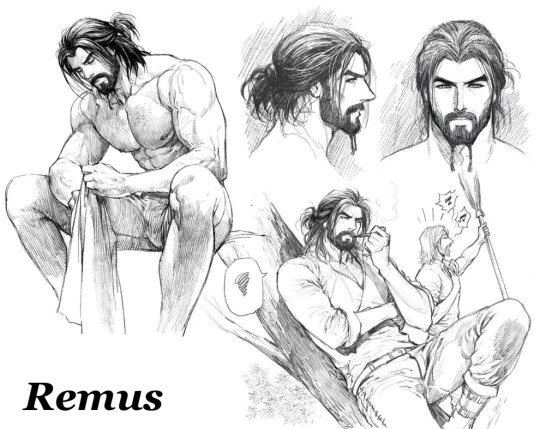

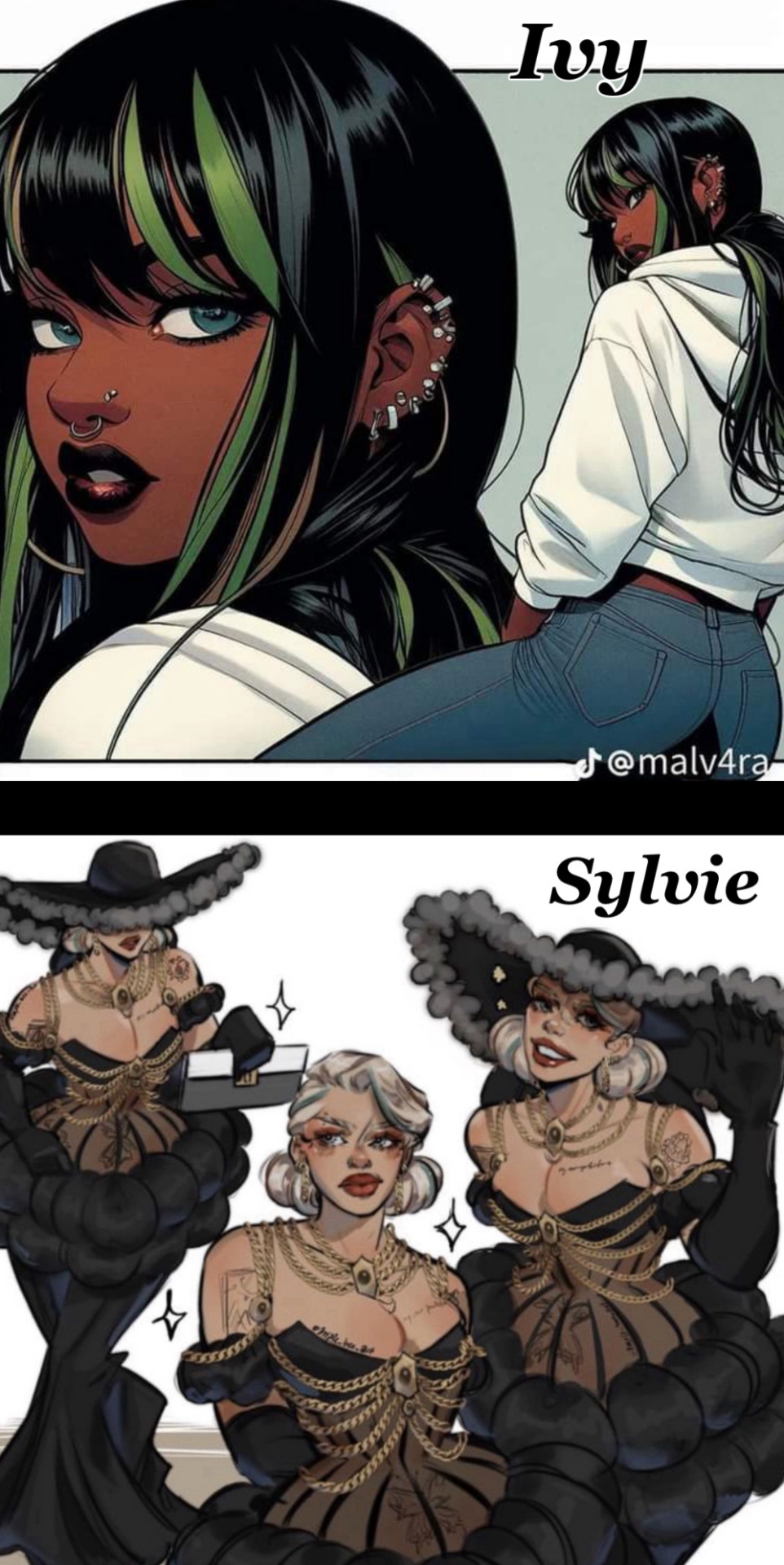
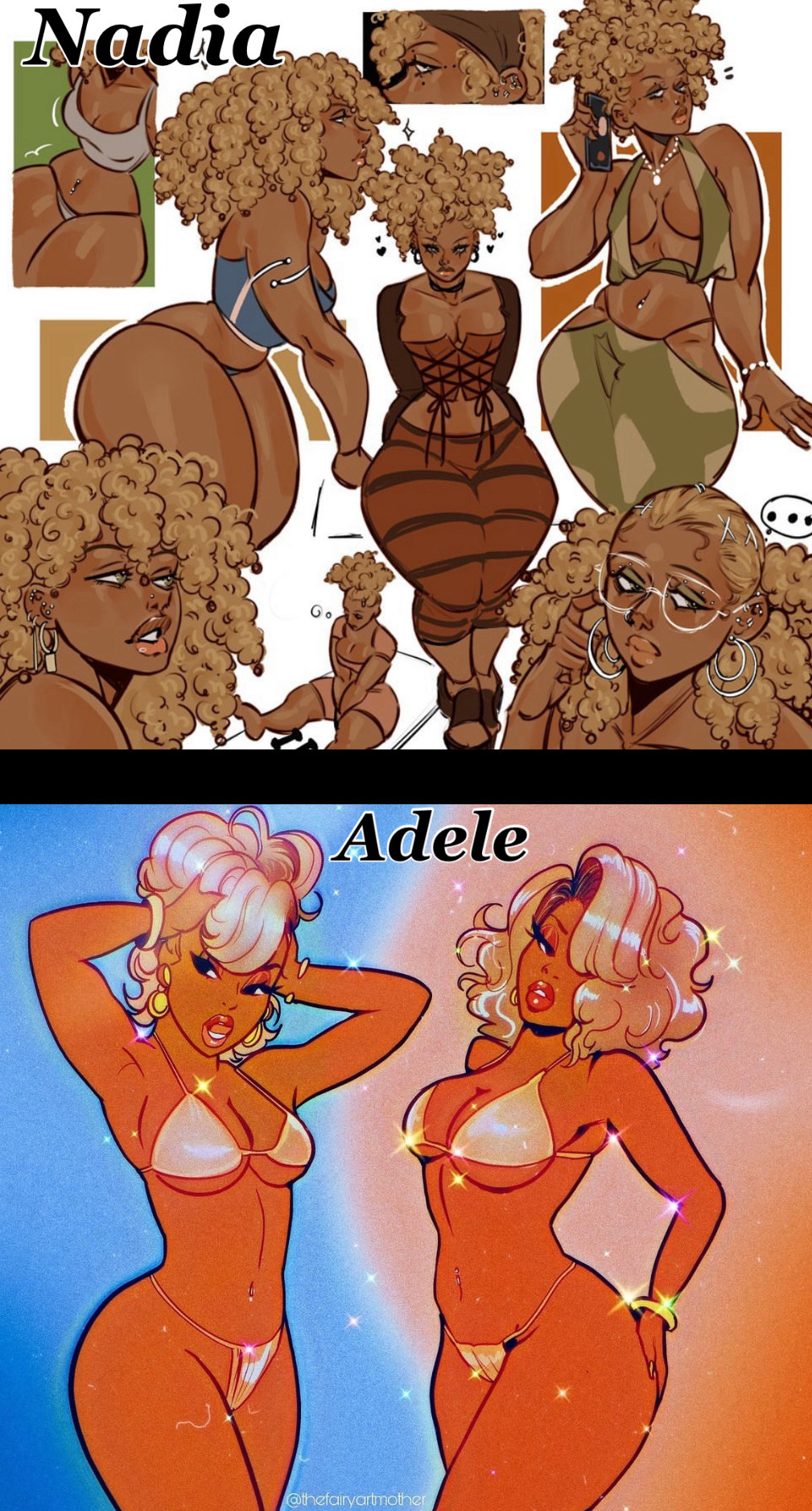
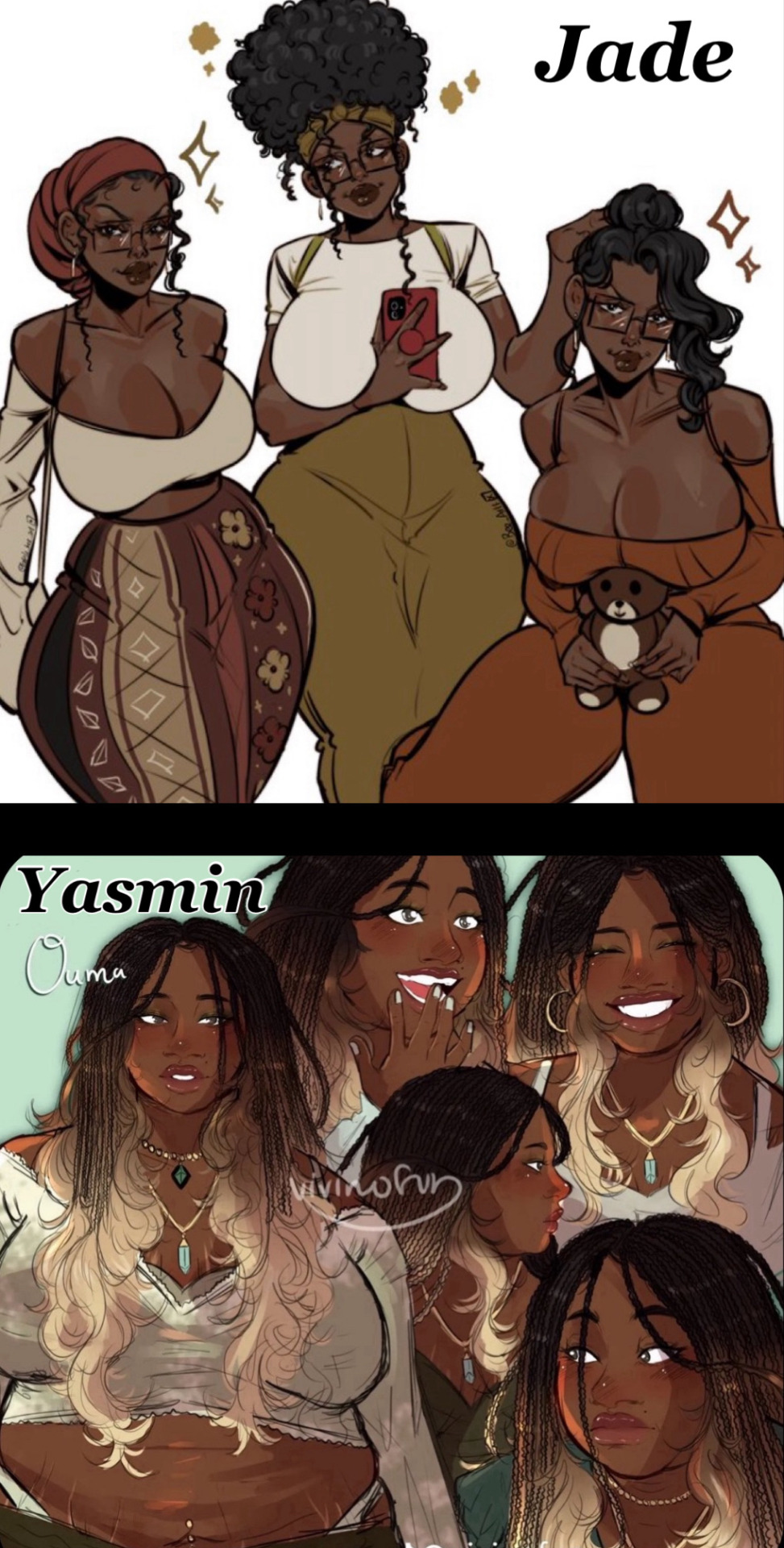
Other than them, I don’t have solid plans to marry in most of my other DRs. My only other husband would be…

🫶: HANA To be honest? My CR little sister who shows up in about half of my scripts as my little sister. If not her, then Juliet Starling, who is my opposite aesthetic best friend in my Lollipop Chainsaw DR.

🐶: Yeah! Not many, though. In several witch DRs, I have a white Burmese Python named Velvet. She’s just a baby and she’s the sweetest thing. She’s my familiar, so she helps me with my magic, protects me, and we have a psychic connection that allows us to communicate. This is what she looks like at only four months.

I also have a Bernese Mountain dog named Titan. Technically, he used to be Remus’ trained dog, but the hard truth is that he just likes us better lol

Thanks for asking!
#reality shifting#shiftblr#shifting realities#desired reality#shifting community#shifting reality#shifting script#black shifters#quantum jumping#shifting#reality shifter#shifting blog#my dr#dr tidbits#zombie apocalypse dr#spectra shifts#inbox#ask me anything#reality shift#shifters#shifting motivation#shifter#long reads#long post
20 notes
·
View notes
Note
thoughts on nonbinary revan?
revan is so nonbinary it's ridiculous. they wake up on a sinking ship with no clue how they got there & a guy basically says 'cmon we have to go rescue princess peach' & rev has such a god complex locked away in their little chest rattling around, so obviously they're like 'sounds like a situation i would be in'.
like. they're a dnd character. they're haunted by the feeling that they should be walking around in a sexier outfit. they're not a jedi or a sith but a secret third thing (gay). they walk around with two enormous swords and take a -6 penalty to hit but fuck it we ball.
i firmly believe that when the historians are writing about revan they simply Do Not gender them and by the time we get to the prequel era the revan discourse has devolved into heated, annotated, footnoted arguments because
1. they're such a lying shit that nobody has any biographical details on them besides 'good hair' and 'slut strut'
2. the historians were actually too busy writing about revan's gay little outfit to be bothered with paying much attention to any physical specificities besides the fact that they're a short king. this is the only undisputed fact about rev.
so yeah basically i think revan is the most nonbinary little asshole of all time
106 notes
·
View notes